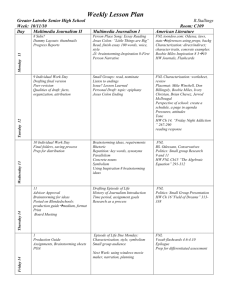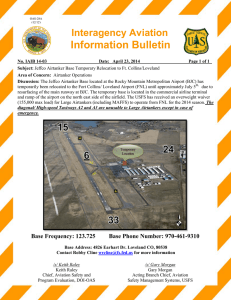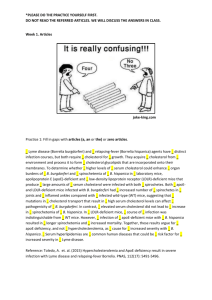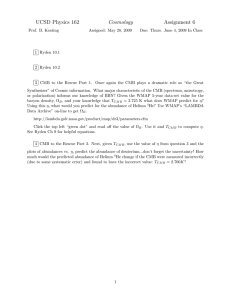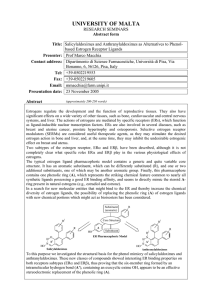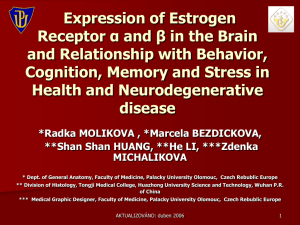Constraints on the non-linear coupling parameter using the CMB nl
advertisement
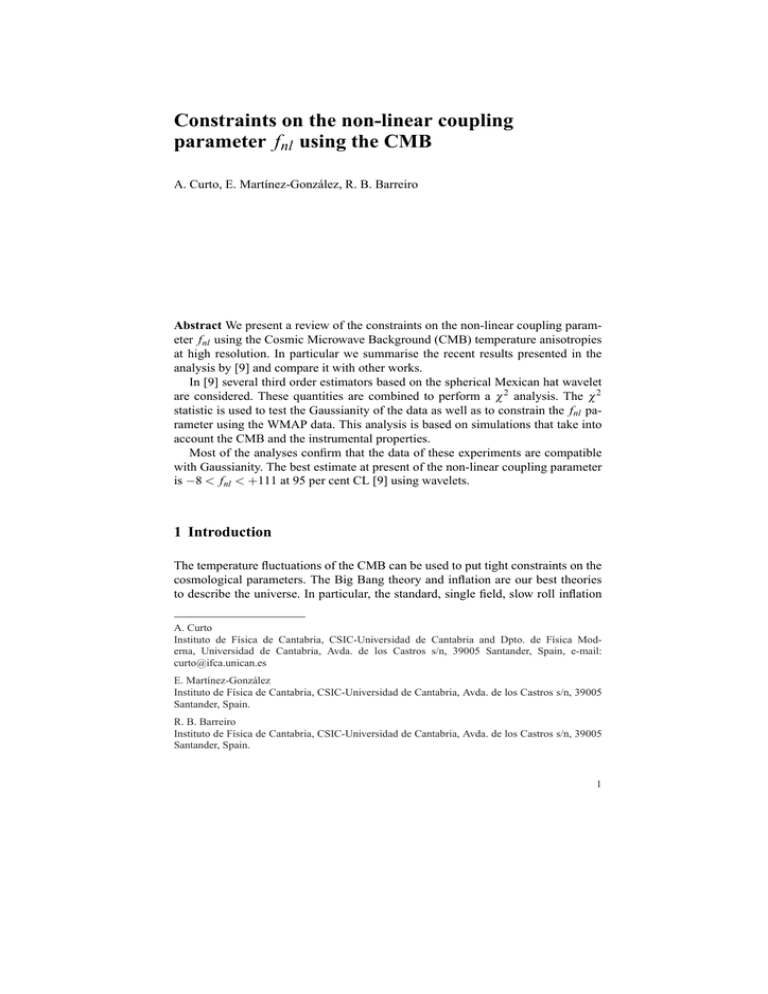
Constraints on the non-linear coupling
parameter fnl using the CMB
A. Curto, E. Martı́nez-González, R. B. Barreiro
Abstract We present a review of the constraints on the non-linear coupling parameter fnl using the Cosmic Microwave Background (CMB) temperature anisotropies
at high resolution. In particular we summarise the recent results presented in the
analysis by [9] and compare it with other works.
In [9] several third order estimators based on the spherical Mexican hat wavelet
are considered. These quantities are combined to perform a χ 2 analysis. The χ 2
statistic is used to test the Gaussianity of the data as well as to constrain the fnl parameter using the WMAP data. This analysis is based on simulations that take into
account the CMB and the instrumental properties.
Most of the analyses confirm that the data of these experiments are compatible
with Gaussianity. The best estimate at present of the non-linear coupling parameter
is −8 < fnl < +111 at 95 per cent CL [9] using wavelets.
1 Introduction
The temperature fluctuations of the CMB can be used to put tight constraints on the
cosmological parameters. The Big Bang theory and inflation are our best theories
to describe the universe. In particular, the standard, single field, slow roll inflation
A. Curto
Instituto de Fı́sica de Cantabria, CSIC-Universidad de Cantabria and Dpto. de Fı́sica Moderna, Universidad de Cantabria, Avda. de los Castros s/n, 39005 Santander, Spain, e-mail:
curto@ifca.unican.es
E. Martı́nez-González
Instituto de Fı́sica de Cantabria, CSIC-Universidad de Cantabria, Avda. de los Castros s/n, 39005
Santander, Spain.
R. B. Barreiro
Instituto de Fı́sica de Cantabria, CSIC-Universidad de Cantabria, Avda. de los Castros s/n, 39005
Santander, Spain.
1
2
A. Curto, E. Martı́nez-González, R. B. Barreiro
[14] predicts that the primordial density fluctuations are compatible with a nearly
Gaussian random field. However, different primordial processes (as for example
topological defects) can introduce non-Gaussian features at certain levels that may
be detectable [6]. Also, several non-standard models of inflation predict a detectable
level of non-Gaussianity in the primordial gravitational potential (see, e.g. [1] and
references therein).
The search of non-Gaussian deviations in the CMB has become a question of
considerable interest, as it can be used to discriminate different possible scenarios
of the early universe and also to study the secondary sources of non-Gaussianity.
High precision CMB experiments are sensitive to deviations due to secondorder effects in perturbation theory, usually parametrised through the local nonlinear coupling parameter fnl . This kind of non-Gaussianity is produced following
a model which introduces a quadratic term in the primordial gravitational potential
[24, 12, 16]
Φ (x) = ΦL (x) + fnl {ΦL2 (x) − hΦL2 (x)i}
(1)
where Φ (x) is a linear random field which is Gaussian distributed and has zero
mean.
This work is a summary of the analyses presented in [9] and other articles (see
Table 1) using the data collected by WMAP and other experiments. The analysis
is based on the Spherical Mexican Hat Wavelet (SMHW) as defined in [23]. In
Section 2 we describe the wavelet and the third order estimators. The results of
the Gaussianity analysis and the constraints on fnl using wavelets are revisited in
Section 3. In Section 4 we present a list of results on the limits on fnl . Finally our
conclusions are summarised in Section 5.
2 Methodology
Several methods can be used to test the Gaussianity of the CMB and to constrain
fnl . We can mention the SMHW, (used recently in [9]), the Minkowski functionals
(see for example [15]) and the angular bispectrum (see for example [20]).
2.1 The SMHW and the estimators
The spherical wavelets have been applied in some analyses to test the Gaussianity
of different data sets (see [9] for a list of examples). Given a function f (n) evaluated
on the sphere at a direction n and the SMHW family on that space, Ψ (n; b, R), we
define the continuous wavelet transform as
Z
w(b; R) =
dn f (n)Ψ (n; b, R)
(2)
Constraints on the non-linear coupling parameter fnl using the CMB
3
Fig. 1 Left panel: the third order statistics corresponding to the V+W WMAP data (diamonds). We
also plot the acceptance intervals for the 68% (inner in red), 95% (middle in green), and 99% (outer
in magenta) significance levels given by 1000 V+W Gaussian simulations of signal and noise.
Right panel: the χ 2 distribution of 1000 V+W Gaussian simulations of signal and noise. The vertical line corresponds to the value obtained from the data.
where b is the position on the sky at which the wavelet coefficient is evaluated and
R is the scale of the wavelet.
The estimators used in [9] are third order combinations of the wavelet coefficients
(Eq. 2) evaluated at several scales from 6.9 arc minutes to 150 arc minutes (see [9]
for a detailed description of the considered scales). These estimators are combined
to perform a χ 2 test by comparing the WMAP data with the expected values of the
Gaussian model and non-Gaussian model with fnl (see Eqs. 7 and 8 of [9]).
3 Results
3.1 Gaussianity analysis with the SMHW
The data analysed in [9] are the 5-year WMAP foreground reduced data maps at
the frequency bands of 41 GHz (Q band), 61 GHz (V band) and 94 GHz (W band).
The maps per different radiometers are combined using the inverse of the noise
variance as an optimal weight. In particular the Q+V+W, Q, V, W, and V+W maps
are considered. The third order estimators are computed for the WMAP data and
for a set of 1000 Gaussian simulations. As we can see in the left panel of Fig. 1
the V+W data are compatible with Gaussian simulations. The results of a χ 2 test
for the V+W data are in the right panel of Fig. 1. The vertical line corresponds to
the χ 2 of the V+W data and the histogram corresponds to the χ 2 of 1000 Gaussian
simulations. Similar results are obtained for the Q, V, W, and Q+V+W combined
maps.
4
A. Curto, E. Martı́nez-González, R. B. Barreiro
3.2 Constraints on fnl with the SMHW
The constraints on fnl presented in [9] are computed using the considered WMAP
data maps and realistic non-Gaussian simulations (see [21, 22] for a description of
these simulations). They also consider Gaussian simulations in order to obtain the
frequentist error bars.
In Fig. 2 we present a plot of χ 2 ( fnl ) versus fnl for the combined V+W WMAP
data and a histogram of the best fit fnl for 1000 Gaussian simulations of the combined V+W map. After considering the contribution of point sources (using a model
based on the work by [11]) the best estimate of fnl is −8 < fnl < +111 at 95%CL.
4 Constraints on fnl from other analyses
Several methods have been used to constrain fnl using the data from different CMB
experiments. The first observational limit on fnl was established by [17] from the
COBE data using the angular bispectrum. The wavelets were used to test Gaussianity and constrain this parameter in [3]. Recent experiments as WMAP and some
balloon-borne experiments, specifically designed to study the anisotropies of the
CMB, have provided more precise limits to this parameter. We can mention the
WMAP team results for the 1-year [18], 3-year [25] and 5-year [20] data releases,
based on the angular bispectrum of the CMB. An independent analysis using the
angular bispectrum was performed by [4, 5]. Some analyses on WMAP data used
other methods as for example the Minkowski functionals [18, 25, 13, 15, 20], local
curvature [2], etc. With respect to the balloon-borne experiments we can mention
the recent analyses of the Archeops data using the Minkowski functionals [7, 8] and
the analysis on the BOOMERanG data by [10]. In Table 1 we summarise the main
results from the previous works.
Fig. 2 From left to right, the χ 2 ( fnl ) statistics for the WMAP combined V+W data map, and the
histogram of the best fit fnl values of a set of 1000 Gaussian simulations of the V+W map.
Constraints on the non-linear coupling parameter fnl using the CMB
5
Table 1 Recent constraints on fnl using different data sets and statistical tools.
Constraints (95% CL)
Method
CMB data
Reference
−8 < fnl < +111
−9 < fnl < +111
−178 < fnl < +64
−36 < fnl < +100
+27 < fnl < +147
−101 < fnl < +107
−70 < fnl < +91
−54 < fnl < +114
−180 < fnl < +170
−27 < fnl < +121
−58 < fnl < +134
−800 < fnl < +1050
−920 < fnl < +1075
SMHW
Angular bispectrum
Minkowski functionals
Angular bispectrum
Angular bispectrum
Genusa
Minkowski Functionals
Angular bispectrum
Local Curvature & wavelets
Angular bispectrum
Angular bispectrum
Minkowski functionals
Minkowski functionals
WMAP-5
WMAP-5
WMAP-5
WMAP-3
WMAP-3
WMAP-3
WMAP-3
WMAP-3
WMAP-1
WMAP-1
WMAP-1
BOOMERanG
Archeops
[9]
[20]
[20]
[5]
[26]
[13]
[15]
[25]
[2]
[4]
[18]
[10]
[8]
a
The Genus is one of the three Minkowski functionals on the sphere.
5 Conclusions
We have presented a review of the constraints on the fnl parameter using the CMB.
In particular, we have summarised the results obtained by [9] using wavelets, which
provides the best constraints on the non-linear coupling parameter up to date, and
compared it with other works. It is interesting to point out that this study includes,
for the first time, inter-scale wavelet estimators to constrain the fnl parameter. Their
results are as good as those obtained by the WMAP team [20] using an optimal
estimator based on the bispectrum (the so-called KSW) [19].
The WMAP data are compatible with Gaussianity and, in particular, the fnl value
that best fits the data is consistent with zero at the 95 per cent CL. This result is in
agreement with most of the reported analyses, including the one of the WMAP team,
and in disagreement with the non-zero fnl reported by [9] (see [26] for a discussion
of this result).
We emphasise the agreement found between the two estimators (the bispectrum
[20] and the wavelets [9]), since they are formed by very different combinations of
the data and therefore they are affected by systematic effects in very different ways.
Acknowledgements We acknowledge partial financial support from the Spanish Ministerio de
Ciencia e Innovación project AYA2007-68058-C03-02. A. C. thanks the Spanish Ministerio de
Ciencia e Innovación for a pre-doctoral fellowship. The authors acknowledge the computer resources, technical expertise and assistance provided by the Spanish Supercomputing Network
(RES) node at Universidad de Cantabria.
6
A. Curto, E. Martı́nez-González, R. B. Barreiro
References
1. Bartolo N., Komatsu E., Matarrese S., Riotto A., 2004, Phys. Rep., 402, 103
2. Cabella P., Liguori M., Hansen F. K., Marinucci D., Matarrese S., Moscardini L., Vittorio N.,
2005, MNRAS, 358, 684
3. Cayón L., Martı́nez-González E., Argüeso F., Banday A. J., Górski K. M., 2003, MNRAS,
339, 1189
4. Creminelli P., Nicolis A., Senatore L., Tegmark M., & Zaldarriaga M. 2006, JCAP, 0605, 004
5. Creminelli P., Senatore L., Zaldarriaga M., & Tegmark M. 2007, JCAP, 0703, 005
6. Cruz M., Turok N., Vielva P., Martı́nez-González E., Hobson M., 2007, Science, 318, 1612
7. Curto A., Aumont J., Macı́as-Pérez J. F., Martı́nez-González E., Barreiro R. B., Santos D.,
Désert F. X., Tristram M., 2007, A&A, 474, 23
8. Curto A., Macı́as-Pérez J. F., Martı́nez-González E., Barreiro R. B., Santos D., Hansen F. K.,
Liguori M., Matarrese S., 2008, A&A, 486, 383
9. Curto A., Martı́nez-González E., Mukherjee P., Barreiro R. B., Hansen F. K., Liguori M.,
Matarrese S., 2008, submitted to MNRAS, arXiv:0807.0231
10. De Troia G., Ade P. A. R., Bock J. J., Bond J. R., Borrill J., Boscaleri A., Cabella P., Contaldi
C. R., et al. 2007, ApJL, 670, L73
11. De Zotti G., Ricci R., Mesa D., Silva L., Mazzotta P., Toffolatti L., González-Nuevo J., 2005,
A&A, 431, 893
12. Gangui A., Lucchin F., Matarrese S., Mollerach S., 1994, ApJ, 430, 447
13. Gott J. R., Colley W. N., Park C.-G., Park C., Mugnolo C., 2007, MNRAS, 377, 1668
14. Guth A. H., 1981, Phys. Rev. D, 23, 347
15. Hikage C., Matsubara T., Coles P., Liguori M., Hansen F. K., Matarrese S., 2008, MNRAS,
389, 1439
16. Komatsu E., Spergel D. N., 2001, Phys. Rev. D, 63, 063002
17. Komatsu E., Wandelt B. D., Spergel D. N., Banday A. J., & Górski K. M. 2002, ApJ, 566, 19
18. Komatsu E., Kogut A., Nolta M. R., Bennett C. L., Halpern M., Hinshaw G., Jarosik N.,
Limon M., Meyer S. S., Page L., Spergel D. N., Tucker G. S., Verde L., Wollack E., Wright
E. L., 2003, ApJS, 148, 119
19. Komatsu E., Spergel D. N., & Wandelt B. D. 2005, ApJ, 634, 14
20. Komatsu E., Dunkley J., Nolta M. R., Bennett C. L., Gold B., Hinshaw G., Jarosik N., Larson
D., Limon M., Page L., Spergel D. N., Halpern M., Hill R. S., Kogut A., Meyer S. S., Tucker
G. S., Weiland J. L., Wollack E., Wright E. L., 2008, submitted to ApJS, ArXiv:0803.0547
21. Liguori M., Matarrese S., Moscardini L., 2003, ApJ, 597, 57
22. Liguori M., Yadav A., Hansen F. K., Komatsu E., Matarrese S., Wandelt B., 2007, Phys. Rev.
D, 76, 105016
23. Martı́nez-González E., Gallegos J. E., Argüeso F., Cayón L., Sanz J. L., 2002, MNRAS, 336,
22
24. Salopek D. S., Bond J. R., 1990, Phys. Rev. D, 42, 3936
25. Spergel D. N., Bean R., Doré O., Nolta M. R., Bennett C. L., Dunkley J., Hinshaw G., Jarosik
N., et al. 2007, ApJS, 170, 377
26. Yadav A. P. S., Wandelt B. D., 2008, Physical Review Letters,100, 181301
